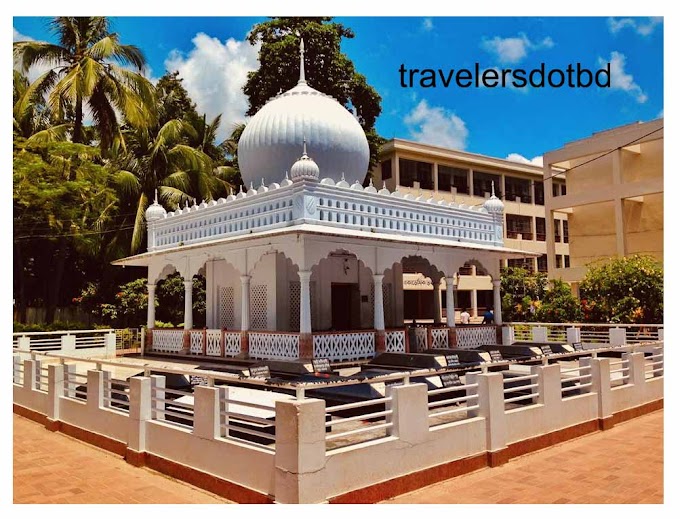Shilaidaha Kuthibari
 | |
|
Overview
Rabindrasmriti is a historical place and tourist center. It is located on the south bank of the Padma in the present Kumarkhali upazila of the present Kushtia district, five miles north of the district headquarters, across the Gorai River, and further north, opposite the town of Pabna on the other bank of the Padma. Shilaidaha is also famous for the historical houses of Sadar Kachari and Jorasanko Tagore family of Birahimpur zamindari.
The name Shilaidaha is modern, earlier this place was known as Khorshedpur. There was an indigo factory here before the Jorasanko Tagore family bought the village in the mid-nineteenth century. It is said to have been built by an indigo planter named Shelley. The village came to be known as Sheli-Daha from a deep ‘Daha’ (whirlpool) created by the confluence of the Gorai and Padma rivers. Over time it became Shilaidaha. Rabindranath's grandfather Dwarkanath Tagore became the owner of the zamindari in 1807 at the behest of Ramlochan Tagore. Rabindranath first came to Shilaidaha in November 1889 to take care of the zamindari.
 |
| Shilaidaha Kuthibari |
Rabindranath Tagore used to come here from time to time in his adolescence and later to look after the zamindari and stay in this house. However, during the subsequent floods, the old house was demolished due to the erosion of the river and the old house was demolished and the new house was built with the old building materials. Rabindranath stayed here at irregular intervals for more than a decade between 1891 and 1901.
During his stay, Sir Jagadish Chandra Bose (Acharya), Dwijendralal Roy, Pramath Chowdhury, Mohitlal Majumder, Lokendranath Palit and other famous scientists, writers and intellectuals of Bengal came here. One of the best crops of Rabindra Sahitya is Sonar Tari, Chitra, Chaitali, Kotha O Kahini, Kshanika, Naibedya and Kheya, most of the poems, stories, plays, novels, letters and songs of Gitanjali and Gitimalya. It was here that the poet began his English translation of Gitanjali in 1912, which earned him the Nobel Prize in 1913. Rabindranath had a deep affection for Shilaidaha and Padma. The poet wrote in a letter: ‘The place of pilgrimage of my youth and old age for literary pursuits was in the Padma-stream-kissed Shilaidaha village.
 |
| Shilaidaha Kuthibari |
Shilaidaha Kuthibari covers an area of about 11 acres with mango, jackfruit and other evergreen orchards, a flower garden and two ponds. Shilaidaha has a rural environment and captivating natural beauty. The Kuthibari building is surrounded by a perimeter wall. It can be entered by crossing a simple but attractive entrance arch located on the south side. It has a total of 15 rooms of different sizes, including a large central hall on the ground floor and second floor. The open balconies on the ground floor and two floors are partially covered by sloping roofs made of Raniganj tiles. In the upper middle part of the ground floor there is a sloping roof with triangular edges. The two-story upper pyramid-shaped roof adds more variety to the building. At present Shilaidaha Kuthibari is a nationally preserved building. The 'Thakur Memorial Museum' has been established here on the initiative of the government.
 |
| Shilaidaha Kuthibari |
It was at Shilaidaha that Rabindranath first began experimenting with rural development and modern methods of farming, which he later put into practice in Patisar. He also established a primary school in Shilaidaha named after his daughter-in-law Pratima Devi.
This mansion in Shilaidaha is now a place of pilgrimage for Rabindranath devotees. The birth anniversary of the poet is celebrated here at the national level on 25th Baishakh every year. A ceremony is also held here on the occasion of the death anniversary of the 22th Shravan Kabir. In these programs, many scholars from home and abroad participated in discussions on the life and work of Rabindranath. At the end of the discussion, eminent artists performed Rabindra Sangeet in the cultural program.
How to go:
Buses of various modes from Gabtoli and Kalyanpur in Dhaka left for Kushtia. Kushtia can also be reached by train from North Bengal and Khulna. From there you can go to Kuthibari by auto.
The house is located at Khoreshadpur in Shilaidaha union under Kumarkhali upazila, just 15 km northeast of Kushtia town. You can leave Shilaidaha from Kushtia city by reserving an auto for only 100 taka.



0 Comments